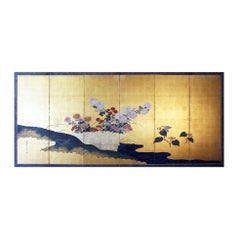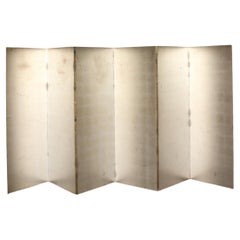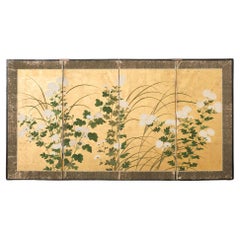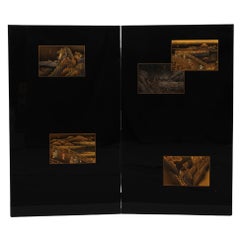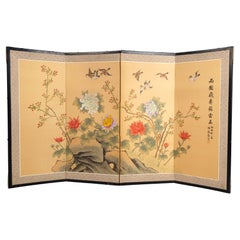Japanese Paintings and Screens
to
134
485
182
872
47
23
9
1
120
349
403
47
178
79
20
25
3
23
10
1
5
14
10
2
493
483
423
331
320
1,590
1,420
919
446
132
919
916
917
29
3
2
2
1
Place of Origin: Japanese
Antique 19th Century Japanese Two-Panel Screen ‘Byobu’, Kano School, Edo Period
Located in London, GB
Japanese Kano School Edo period two-panel screen depicting flowering prunus and bamboo on a rock formation, with colorful birds next to a body of water. ...
Category
Mid-19th Century Edo Antique Japanese Paintings and Screens
Materials
Gold Leaf
Japanese Byobu - Japanese Folding Screen Gold Leaf
By Japanese Studio
Located in Brescia, IT
Floral scene of a "Rimpa School" garden with polychrome chrysanthemum flowers.
Six-panel screen painted with pigments on golden rice paper of good size and well preserved.
Bold color...
Category
Early 19th Century Edo Antique Japanese Paintings and Screens
Materials
Gold Leaf
B22 Japanese Antiques 6panels, Silver Paper, folding Screen
Located in Niiza, JP
Silver foil folding screen
Material: Paper pasted on wooden frame
1 piece: Width 595 x Height 1740 x Depth 18 mm
Expanded size: Width 3610 mm
Folded size: Width 615 x Height 1740 x D...
Category
20th Century Japanese Paintings and Screens
Materials
Paper
Japanese Edo Four Panel Screen Flowering White Chrysanthemums
Located in Rio Vista, CA
19th century extraordinary Japanese late Edo/early Meiji period four-panel byobu screen featuring flowering white chrysanthemums painted in a moriage (raised pigment) style. The pain...
Category
19th Century Edo Antique Japanese Paintings and Screens
Materials
Brass, Gold Leaf
Tall, Japanese lacquer byôbu 屏風 (folding screen) by Mitsuo Takana 高名光夫 (1956)
By Mitsuo Takana
Located in Amsterdam, NL
Refined, tall two-panel byôbu (folding screen) completely adorned with ‘Wajima Ryûsaku’ lacquer by the Nitten award winning artist Mitsuo Takana (1956).
Featuring five refined images inspired by woodblock prints from the famous series ‘Tôkaidô gojûsan tsugi’ (The fifty-three stations of the Tokaido road), like the 1st station Nihonbashi, the 10th station Hakone, and the 21st station Okabe.
The design is executed in hiramaki-e (low-relief lacquer design) in shades of gold, silver, heightened by some multi-coloured details. Set on a shiny black lacquer substrate.
Signed in red lacquer in the lower right corner.
Including original signed & sealed wooden tomobako (storage box). The front with an inscription about the contents as described above. The inside:
‘Friend of the Nitten Exhibition Takana Mitsuo’ - Seal: ‘Hikari’.
‘Lacquer artist Wajima Ryûsaku’ - Seal: ‘Ryûsaku’.
Mitsuo Takana was born 1956 in Wajima, Ishikawa prefecture. He won several awards during exhibitions like: Ishikawa Contemporary Art Exhibition, Japan Artisans' Association Exhibition and the well-known Nitten Exhibition.
Dimensions:
Height 57.48 in/146 cm, Total width 66.92 in/170 cm (2 x 33.46 in/85 cm), Depth 1.10 in/2.8 cm.
Weight 56.21 lb/25.5 kg.
Wajima lacquerware...
Category
Late 20th Century Japanese Paintings and Screens
Materials
Wood, Giltwood, Lacquer
Japanese Four-Panel Folding Screen Byobu Signed Showa Period C.1950
Located in London, GB
A four-panel Japanese Byobu folding screen depicting a floral scene with birds.
Japan, C.1950 Showa Period
An attractive example, beautifully h...
Category
Mid-20th Century Showa Japanese Paintings and Screens
Materials
Silk, Paper
Japanese Painting, Hanging Scroll, Mid 19th Century, Koi and Water Plants
By Iwase Hirotaka
Located in Kyoto, JP
Iwase Hirotaka (1808-1877)
Koi and Water Plants
Hanging scroll, ink, color, gold wash and gold flecks on silk
Inscription: Hirotaka
Seal: Ille...
Category
1860s Edo Antique Japanese Paintings and Screens
Materials
Silk
Japanese Screen Painting, circa 1700 'Horses' by Kano Tanshin
Located in Kyoto, JP
Horses
Kano Tanshin Morimasa (1653-1718)
Two-panel tea-ceremony Japanese screen or furosaki
Ink on gold leaf,
late 17th-early 18th century
Measures: H 55 cm x W 182 cm
The Kano school was closely aligned with the warrior class in Japan. The samurai, who lived in a closed and rigid hierarchical society established by the Shogunate, were drawn to the energy and freedom horses symbolize; Kano school artists commonly depicted the equine creatures as they are here, in unfettered and carefree family groups. China originally introduced horse paintings to Japan; the works typically focused on capturing the essence of horses in their various environments and often involved integrating human figures into the images.
Kano Tanshin Morimasa (1653-1718) was the son of Kano Tanyu...
Category
1690s Edo Antique Japanese Paintings and Screens
Materials
Gold Leaf
19th Century Shibayama Four Panel Screen Meiji Period Japan, C.1880
Located in London, GB
19th century Shibayama four Panel screen Meiji Period Japan C.1880
Mother of pearl inlay in black lacquer depicting a bird in relief with cherry blossom. The lower section with gilt panels, and the reverse red lacquer with tree silhouettes.
Category
19th Century Meiji Antique Japanese Paintings and Screens
Materials
Mother-of-Pearl, Wood, Lacquer
Meiji Period Silver Oxidized Screen
Located in Fukuoka, JP
Meiji Period Silver Oxidized Screen
Period: Meiji
Size: 174 x 174 cm (68.5 x 68.5 inches)
SKU: PTA107
Step back in time with this Meiji period screen, where the allure of silver ox...
Category
19th Century Meiji Antique Japanese Paintings and Screens
Materials
Silver Leaf
Japanese Showa Two Panel Screen Pair of Tethered Hawks
Located in Rio Vista, CA
Captivating Japanese Showa period two-panel folding byobu screen featuring a pair of hawks or birds or prey tethered to a wooden perch. The painting has ink and natural colored pigme...
Category
20th Century Showa Japanese Paintings and Screens
Materials
Brass
Japanese Painting, Framed Panel, Willow and Sparrows, circa 1920 Taisho era
Located in Kyoto, JP
Anonymous
Summer willow and sparrows
Taisho period, circa 1920
Framed painting. Mineral pigments, mica, gold, ink and gofun on silk
Dimensions (framed):
H. 98 cm x W. 135 cm x D...
Category
1920s Taisho Vintage Japanese Paintings and Screens
Materials
Wood, Silk
Lovely Nihonga Scene Taisho / Showa Period Scroll Japan Artist Prunus Blossom
Located in Amsterdam, Noord Holland
It is a work drawn by Doun as you can see.
It is a simple yet calm white plum blossom map, which is
very tasty.
¦Paper books and handwriting.
¦ State
...
Category
19th Century Meiji Antique Japanese Paintings and Screens
Materials
Silk
$803 Sale Price
20% Off
Late 17th Century Japanese Screen. Puppy and Kittens on Gold Leaf.
Located in Kyoto, JP
Anonymous
Late 17th century
Puppy & Kittens
A six-panel Japanese screen. Ink, color, gofun, gold-leaf and gold-fleck on paper.
A medium sized late 17th century Japanese screen fe...
Category
Late 17th Century Edo Antique Japanese Paintings and Screens
Materials
Gold Leaf
Japanese Edo Six Panel Screen Yoshitsune and Benkei
Located in Rio Vista, CA
Spectacular 19th century Japanese late Edo period six-panel byobu screen depicting Yoshitsune and Benkei, two heroes of Japanese folklore. Crafted in ink and natural color pigments on mulberry paper with thick gold leaf borders on each panel. The character Yoshitsune is seated under a blossoming cherry tree in full armor holding a fan. The warrior priest or monk Benkei is depicted kneeling on a leopard skin...
Category
19th Century Edo Antique Japanese Paintings and Screens
Materials
Brass, Gold Leaf
$3,400 Sale Price
29% Off
B41 Japanese Antiques 6panels, Silver Paper, folding Screen, brown-rimmed
Located in Niiza, JP
Material: Paper, wooden frame
1 piece: Width 435 x Height 1370 x Depth 18 mm
Expanded size: Width 2650 mm
Folded size: Width 455 x Height 1370 x Depth 100 mm, weight 9 kg
Packaging (...
Category
20th Century Japanese Paintings and Screens
Materials
Paper
Japanese Meiji Two Panel Screen Flowering Autumn Plants
Located in Rio Vista, CA
Fascinating Japanese 19th century meiji period two panel folding byobu screen. The screen features flowering autumn plants and grasses: chrysanthemum, brush clover, Chinese bellflowe...
Category
19th Century Meiji Antique Japanese Paintings and Screens
Materials
Silver Leaf
Japanese Painting, Framed Panel, Dahlias and Roosters, circa 1920
Located in Kyoto, JP
Tanaka Tessen (b.1890)
Dahlias and Roosters
Taisho period, circa 1920
Framed painting. Mineral pigments and ink on silk.
Dimensions (framed):
H. 159 cm x W. 97 cm x D. 2.5 cm (62.5” x 38” x 1”)
An ornate and complex composition in which the artist explores almost the entire painting surface. The coloration is bold and evocative and the tinted silk ground recreates the warm golden glow of sunset. Soft, luminous brushwork details the black feathers of the roosters, which seem to cloud and blur in counterpoint to the sharper points of the eyes and beaks. Their brilliant red combs balance the composition, echoing the rich burgundy hues of the dahlias; the flowers exquisite and lifelike. Dahlias were an exotic subject favored by painters of the Taisho era.
The painting belongs to the school of Kyoto Nihonga, exemplifying the principles of decorative elegance and consumate brush technique with which it was intimately associated. Painters of the time relied on the Shijo school method, basing the forms of the composition from life sketches. Sometimes they were then integrated with elements derived from Chinese bird and flower...
Category
1920s Taisho Vintage Japanese Paintings and Screens
Materials
Wood, Silk
19th Century Japanese Screen for Tea-Ceremony, Ink Bamboo and Plum on Gold Leaf
Located in Kyoto, JP
Three Friends of Winter
Nakajima Raisho (1796-1871)
Late Edo period, circa 1850
Ink and gold leaf on paper.
This is a double-sided Japanese Furosaki or tea-ceremony screen from the mid 19th century; bamboo and plum on the front, young pines the back. It by Nakajima Raisho, a master painter of the Maruyama school in the late Edo and early Meiji periods. In this work Raisho combines exquisite ink brushwork with large open spaces of brilliant gold-leaf to inspire the viewers imagination. Rather than naturalism, he is searching for the phycological impression of the motifs, resulting in abstraction and stylization. His simplification of the motifs the result of looking to capture the inner nature of the objects. This art motif is known as Sho Chiku Bai, or the Three Friends of Winter. Evergreen pine connotes steadfastness, bamboo suggests both strength and flexibility, while plum blossoms unfurling on snow-laden branches imply hardiness. Combined, this trio is emblematic of Japanese new year. Chinese literati were the first to group the three plants together due to their noble characteristics. Like these resilient plants flowering so beautifully in winter, it was expected of the scholar-gentleman to cultivate a strong character with which he would be able to show the same degree of perseverance and steadfastness even during times of adverse conditions.
The screen would have been placed near the hearth of a room used for the Japanese tea ceremony, shielding the fire from draughts and also forming a stimulating and decorative backdrop behind the tea utensils. It would have been used in the Hatsugama, or first tea-ceremony of the new year.
Nakajima Raisho (1796-1871) originally studied under Watanabe Nangaku before entering the school of Maruyama Ozui. He was the highest ranking Maruyama school painter at the end of the Edo period and was known as one of the ‘Four Heian Families’ along with Kishi...
Category
Mid-19th Century Edo Antique Japanese Paintings and Screens
Materials
Gold Leaf
B9 Japanese Antiques Silver folding screen, 2panel
Located in Niiza, JP
Unfolded size: 1700 x 1700 x 20 mm
Foldable: 850 x 1700 x 40 mm, 7kg
Estimated size after packaging (sandwiched between 5-10 mm plywood):
10 cm x 92 cm x 182 cm Weight 30 KG
A bea...
Category
20th Century Japanese Paintings and Screens
Materials
Paper
Japanese Six-Panel Screen Byobu With Chrysanthemums And Autumn Grass and Flower
Located in Torino, IT
The 19th Century Six-Panel Japanese folding screen "Byōbu" usually used in the most important Japanese house to stop wind and also to separate different space of the same big room de...
Category
Mid-19th Century Edo Antique Japanese Paintings and Screens
Materials
Gold Leaf
Japanese Showa Period Peacocks Painted on Silk
Located in Rio Vista, CA
Colorful Japanese ink and color on silk Showa painting of a pair of peacocks. Vivid colors and beautiful details with a signature and seal on right side bottom. Framed in a midcentur...
Category
20th Century Showa Japanese Paintings and Screens
Materials
Silk, Plexiglass, Paper, Wood
$1,440 Sale Price
20% Off
Japanese Four Panel Paper Screen
Located in Essex, MA
Pair of two panel screens with a rooster and a hen in amongst bamboo. Signed by the artist Ema Saiko 1787-1861. A Japanese painter, poet and calligrapher celebrated for her Chinese...
Category
1850s Antique Japanese Paintings and Screens
Materials
Paper
$6,800 / set
Japanese Showa Four Panel Screen Spring Flowers on Gilt
Located in Rio Vista, CA
Charming mid-20th century Japanese Showa period four-panel folding byobu screen featuring blossoming spring flowers over a bold gilt background. The painting depicts iris, camella, w...
Category
20th Century Showa Japanese Paintings and Screens
Materials
Brass
Japanese Edo Six-Panel Haboku Landscapes of Seasons
Located in Rio Vista, CA
19th century Japanese Edo period six-panel screen painted in Haboku (splashed ink) style. Depicts Four Seasons landscape scenes with two portraits of Chinese sages. One sage is trave...
Category
19th Century Edo Antique Japanese Paintings and Screens
Materials
Gold Leaf
Japanese Painting, 17th Century, Tale of Genji, Tosa School
Located in Kyoto, JP
Illustration to an unidentified chapter of the Tale of Genji (Genji Monogatari)
Tosa School (second half of the 17th Century)
Ink, pigment, gofun and...
Category
Late 17th Century Edo Antique Japanese Paintings and Screens
Materials
Gold Leaf
Japanese Asian Large Edo Six-Panel Folding Byobu Screen Landscape Monkeys Trees
Located in Studio City, CA
An absolutely gorgeous, wonderfully composed six-panel Japanese Byobu folding screen/room divider depicting a family of playful monkeys among the blooming trees and mountainous lands...
Category
Early 19th Century Edo Antique Japanese Paintings and Screens
Materials
Gold Leaf
17th Century Japanese Screen Pair by Soga Nichokuan, Hawks on Pine & Plum Trees
Located in Kyoto, JP
Hawks on plum and pine
Soga Nichokuan (active circa 1625-1660)
Pair of six-fold screens.
Ink, mineral pigments, gofun, gold and speckled gold l...
Category
1640s Edo Antique Japanese Paintings and Screens
Materials
Wood, Paper
Japanese Scroll Hand Painting in Black Ink of a Landscape, Early 20th Century
Located in Savannah, GA
Japanese Scroll Hand Painting in Black Ink of a Landscape, Early 20th Century
Category
Early 20th Century Japanese Paintings and Screens
Materials
Paper
Japanese Chinese Korean Asian Signed Framed Hand Painted Tiger Scroll Painting
Located in Studio City, CA
A beautiful and striking framed Asian tiger scroll painting featuring a regal tiger in the moonlight. This work is hand-painted with masterful brushstroke...
Category
Early 20th Century Showa Japanese Paintings and Screens
Materials
Silk, Wood, Paint
Japanese Three Garden Rabbits Family, Usagi
Located in South Burlington, VT
From our recent Japanese acquisitions and coming from a Japanese collector of rabbit usagi sculptures
Rabbit family trio (3) seated rabbit sculptures hand cast and hand painted
This is an unusual Japanese one-of-a-kind group in both large and small scale
Quality: Hand cast with carved ears...
Category
Mid-20th Century Showa Japanese Paintings and Screens
Materials
Bronze, Iron
$280 Sale Price / set
62% Off
Mid 19th Century Framed Japanese Painting. Snail, Wasp & Hollyhock.
Located in Kyoto, JP
Obata Tosho (1812-1886)
Snail, Wasp & Hollyhock
Late Edo period, mid 19th Century
Framed Japanese Painting. Ink and color on paper.
Individually framed 19th century bird and flow...
Category
Mid-19th Century Edo Antique Japanese Paintings and Screens
Materials
Paper
B31 Japanese Antiques 2panels, paper, folding Screen with flower
Located in Niiza, JP
Material: paper on wooden frame
One piece: W755×H1520mm×D15mm,
Unfolded size: W1510mm
Folded size: W755×H1520×D30mm, 5kg
Packaging (sandwiched with 5-10mm plywood): 15cm x 86cm x 16...
Category
19th Century Antique Japanese Paintings and Screens
Materials
Paper
Edo 19th Century Japanese Folding Screen Six Panels Battle of Menpei
By Japanese Studio
Located in Brescia, IT
Samurai on horseback and by boat from the famous battle of Menpei Japanese folding screen six-panel of "Tosa School" painted with mineral pigments on vegetable on golden silk , earl...
Category
Early 19th Century Edo Antique Japanese Paintings and Screens
Materials
Gold Leaf
Japanese Two Panel Screen: Pine in Snow
Located in Hudson, NY
Kano School, Mineral pigments on gold leaf with silk brocade border and lacquer wood trim.
Category
Mid-19th Century Antique Japanese Paintings and Screens
Materials
Gold Leaf
The Plovers over the Sea Shores Screen
Located in Fukuoka, JP
The Plovers over the Sea Shores Screen
Period: 18th century (Edo period)
Size: 360 x 170 cm (141.7 x 66.9 inches)
SKU: PA39
Travel back in time with this classic Edo period screen,...
Category
18th Century Edo Antique Japanese Paintings and Screens
Materials
Wood, Paper
Paravento Giapponese a due pannelli
By Japanese Studio
Located in Brescia, IT
Sempre alla ricerca di cose particolari abbiamo acquistato questo paravento giapponese da una collezionista di Osaka.
Un esempio di arte del novec...
Category
20th Century Showa Japanese Paintings and Screens
Materials
Gold
Japanese Bijin-ga Painting of Woman in Period Kimono, Taisho Period, circa 1920
Located in Prahran, Victoria
Rare Japanese Taisho period Bijin-ga style painting of a beautiful woman in period kimono holding a fan, circa 1920.
Bijin-ga is a Japanese term used to describe paintings or pict...
Category
1920s Taisho Vintage Japanese Paintings and Screens
Materials
Silk
B20 Japanese Antiques 2panels, Paper, folding Screen with Pine Tree and Crane
Located in Niiza, JP
Pine Trees and Cranes
Materials: Paper on Wooden Frame, Colored
One piece: W865×H1760mm,
unfolded size: W1730mm, 6kg
Folded size: W865×H1760×D35mm
packaging estimate (sandwiched with...
Category
Early 20th Century Japanese Paintings and Screens
Materials
Paper
Japanese Edo Six Panel Screen Flowering Morning Glory
Located in Rio Vista, CA
Spectacular 19th century late edo period six panel byobu screen featuring flowering morning glory vines (as-agao). Machi-eshi or anonymous town artist painter crafted in an amalgamat...
Category
19th Century Edo Antique Japanese Paintings and Screens
Materials
Brass
19th Century Japanese Edo Screen Kano School Garden Terrace
Located in Rio Vista, CA
Fantastic 19th century Japanese Edo/Tokugawa period two-panel byobu screen featuring Chinese children frolicking on a garden terrace with a pavilion and large pine tree. Made in the ...
Category
19th Century Edo Antique Japanese Paintings and Screens
Materials
Brass, Gold Leaf
Mid 19th Century Framed Japanese Painting. Spider & Morning Glory.
Located in Kyoto, JP
Obata Tosho (1812-1886)
Spider & Morning Glory
Late Edo period, mid 19th Century
Framed Japanese Painting. Ink and color on paper.
Individually framed 19th century bird and flowe...
Category
Mid-19th Century Edo Antique Japanese Paintings and Screens
Materials
Paper
Edo Period (19th) Japanese antique painting of flowers
Located in Fukuoka, JP
Japanese antique painting of flowers 19 C
Weight 3kg ( 6.6lb)
Category
Mid-19th Century Edo Antique Japanese Paintings and Screens
Materials
Silk, Paper
Early 20th Century Japanese Nihonga Scroll. Crow & Persimmon.
Located in Kyoto, JP
Anonymous.
Crows & Persimmon
Japanese Scroll. Pigments and Ink on Silk.
Dimensions:
Scroll: H. 235 cm x W. 106 cm.
Image: H. 168 cm x W. 86 cm.
Bird and flower paintings are oft...
Category
Early 20th Century Taisho Japanese Paintings and Screens
Materials
Silk
B20 Japanese Antiques 6panels, Silver Paper, folding Screen
Located in Niiza, JP
Silver-covered folding screen
Material: Paper on wooden frame
One piece: W600×H1745mm×D20mm,
Unfolded size: W3630mm
Folded size: W615×H1745×D105mm, 12kg
Packaging (sandwiched with 5m...
Category
20th Century Japanese Paintings and Screens
Materials
Paper
Japanese Painting, Hanging Scroll, 19th Century Bamboo in Moonlight
Located in Kyoto, JP
Bamboo in moonlight
Gamo Rakan (1784-1866)
Hanging scroll, ink on silk.
Dimensions:
Scroll: 201 cm x 58 cm
Image: 137 cm x 45 cm
In this early 19th century work by Gamo Rakan a light ink wash applied to the silk background silhouettes the moon and suggests the atmosphere of early evening. Even though it is a literati subject, Rakan’s bamboo is quite realistic with a strong decorative style. The painting finds its inspiration from Chinese Ming dynasty painters who often used a single-tone, jet black stroke to emphasize the calligraphic nature of bamboo.
In a different era, decorative would have been seen as somewhat unrefined. But increasingly in the Edo period, it was the hallmark of high style. The Japanese people, in particular the rising merchant class, had gradually become apathetic toward the traditional Sesshu and Kano schools of painting. Chinese professional and amateur painters living in the port of Nagasaki during the 18th century had a profound effect on Japanese painting and the freshness of their style and its decorative appeal contributed greatly to its popularity. Gamo Rakan’s teacher, Tani Buncho...
Category
Early 19th Century Edo Antique Japanese Paintings and Screens
Materials
Silk
Antique Japanese Suibokuga Landscape by Kano Tokinobu, 17th century.
Located in Point Richmond, CA
Antique Japanese Suibokuga Landscape by Kano Tokinobu, 17th century. A sumi-e ink on paper painting illustrating a rocky seaside landscape containing buildings, vegetation and ship masts. The painting with 3 vermillion seals of the artist in the lower left corner. Japanese dry mount paper on a wood frame with thin brocade border silver leafed surround and lacquered wood outer frame.
Condition: Lighter discoloration near the bottom of the painting, various paper restorations, other minor signs of age, wear, stains, otherwise fine condition.
Age: Painting Edo Period, circa 1670. Mounting circa 1985.
Image: 51-1/2 in. x 20-1/2 in. (131cm x 52cm)
Frame: 59-1/4 in. x 25-1/4 in. (150cm x 64cm)
Weight: 6 lbs.
Provenance:
with Honeychurch Antiques...
Category
1670s Edo Antique Japanese Paintings and Screens
Materials
Paper
B7 Japanese Antiques Silver Screen, 6-panel Byobu
Located in Niiza, JP
Size when unfolded: 3480 x 1180 x 15 mm
Can be folded to 580 x 1180 x 105 mm. 7㎏
Estimated size after packaging (sandwiched between 5 mm plywood):
22 CM x 70 CM x 130 CM Weight 22 K...
Category
20th Century Japanese Paintings and Screens
Materials
Paper
17th century Japanese Falcon Painting, Mitani Toshuku, Unkoku School
By Mitani Toshuku
Located in Kyoto, JP
Mitani Toshuku (1577-1654)
“Falcon”
Wall panel, ink and light color on paper.
Upper Seal: Mitani
Lower Seal: Toshuku
Dimensions:
Each 118.5 cm x 51 cm x 2 cm (46.5” x 20” x .75”)
Individual falcon paintings by Mitani Toshuku (1577-1654), an early artist of the Unkoku School. Founded by Unkoku Togan (1547–1618), a master of the Momoyama period, the Unkoku school enjoyed long lasting patronage in southern Japan. Togan was a retainer of the Mori family in present day Yamaguchi prefecture. Members of the school considered themselves to be in the artistic lineage of Sesshu Toyo...
Category
Early 17th Century Edo Antique Japanese Paintings and Screens
Materials
Paper
Antique Japanese Wood Block Printed Table Top Folding Screen
Located in San Francisco, CA
Antique Japanese small table top four panel folding screen.
Wood block print on paper.
First quarter 20th century.
Perfect to use as wall art.
Category
Early 20th Century Meiji Japanese Paintings and Screens
Materials
Paper
17th Century Japanese Screen. Ink Plum Tree & Birds by Kano Naonobu.
Located in Kyoto, JP
Kano Naonobu (1607-1650)
Plum Tree and Birds
Six-fold Japanese Screen. Ink and slight color on paper.
In this evocative ink work spread over a six-panel folding screen, we see the consummation of the elegance and refinement of the Edo Kano school. This 17th century screen is a rare surviving example of a large-scale bird and flower painting by Kano Naonobu, the younger brother of Kano Tanyu...
Category
17th Century Edo Antique Japanese Paintings and Screens
Materials
Wood, Paper
Pair of Japanese Edo Six Panel Screens the Seven Sages
Located in Rio Vista, CA
Fantastic pair of 19th century Japanese late Edo/early Meiji period six-panel screens titled The seven sages of the bamboo grove. The Kano school screens...
Category
19th Century Edo Antique Japanese Paintings and Screens
Materials
Brass, Gold Leaf
19th C. Edo-Meiji Period Japanese Painted Five-Panel Folding Miniature Screen
Located in North Miami, FL
19th century/Edo-Meiji period japanese painted five-panel folding miniature screen
By: unknown
Material: lacquer, metal, paint, wood
Technique: carved, hand-carved, hand-painted, la...
Category
19th Century Meiji Antique Japanese Paintings and Screens
Materials
Metal
The sky visible at Honmonji TempleⅣ by Blue Tip Atelier
Located in Sammu-shi, Chiba
Title : The sky visible at Honmonji TemplⅣ
Japan / 2024s
Size : W 275 H 395mm
A mini series of the sky as seen from Honmonji Temple.
Natural dyes used are Indian madder and oak g...
Category
2010s Modern Japanese Paintings and Screens
Materials
Linen
Japanese Fine Antique Pair Gilt Bronze Mandarin Duck Screen Holders
Located in South Burlington, VT
Best Quality, Hard To Find, complete with antique wooden collector box tomobako
A fine pair (2) of Japanese antique hand cast gilt bronze Mandarin Duck screen holders with highly d...
Category
Late 19th Century Meiji Antique Japanese Paintings and Screens
Materials
Bronze
Japanese Six Panel Screen: Ink Painting of a Weathered Pine Tree
Located in Hudson, NY
Meiji period (1868 - 1912) sumi-e (or ink painting) on paper of a venerable pine tree with limbs stretching out over a bluff. Beautiful signature and seal read: Biei. Ink on paper ...
Category
19th Century Antique Japanese Paintings and Screens
Materials
Brocade, Silk, Paper
ICHIMATSU by Blue Tip atelier
Located in Sammu-shi, Chiba
Title : ICHIMATSU
Japan / 2020s
Size : W 1480 x H 1480 mm
Each part is dyed with indigo to express a checkered pattern that collapses. This quilt is made with Woven fresh linen. Hand-quilted with cotton thread. Hand dyed with indigo.
[Blue Tip atelier...
Category
2010s Modern Japanese Paintings and Screens
Materials
Linen
The Plovers over the Sea Shores Screen (2/2)
Located in Fukuoka, JP
The Plovers over the Sea Shores Screen
Period: 18th century (Edo period)
Size: 360 x 170 cm (141.7 x 66.9 inches)
SKU: PA39
Travel back in time with this classic Edo period screen,...
Category
18th Century Edo Antique Japanese Paintings and Screens
Materials
Wood, Paper
Lovely Nihonga Scene Meiji/Taisho Period Scroll Japan Artist Reika Yoshikawa
Located in Amsterdam, Noord Holland
Reika Yoshikawa (Reika Yoshikawa, Meiji eight years (1875) May 4 days-Showa 4 years (1929) March 25), the Meiji Taisho era Japan painter. His real name is Hitoshi, commonly known as Saburo.
Yamato-e basic widely while the oriental of classical learning in art, line drawing, especially in Seiga paintings representation by taking advantage of beautiful thin line, such as flow, "draw" from "null" to the center of gravity is going modern...
Category
19th Century Meiji Antique Japanese Paintings and Screens
Materials
Silk
$897 Sale Price
20% Off
Pair of Japanese Silver Leaf Meiji Period Painted Screens
Located in Dallas, TX
The product is a pair of Japanese silver leaf Meiji period painted screens. These screens showcase intricate artwork and designs typical of the Me...
Category
19th Century Antique Japanese Paintings and Screens
Materials
Wood
Recently Viewed
View AllMore Ways To Browse
Lattice Panel Wood
Hanging Japanese Screen
Japanese Lattice
Japanese 19th Century Meiji Period Silk Painting
Japanese Buddhist Screen
Japanese Carved Screen
Japanese Screens And Doors
Japanese Autumn Screen
Japanese Screens Six Fold
Japanese Wood Room Divider
Kyoto Silk Painting
Japanese Dragon Painting
Japanese Birds Painted On Silk
Heian Period
Japanese Crane Panel
Japanese Divider Screen
Japanese Pheasant
Japanese Screen Chrysanthemums

